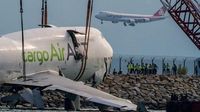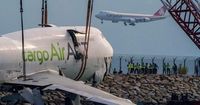In a dramatic and tragic turn of events, authorities in Hong Kong have recovered the main wreckage of a cargo plane from the waters off the city’s coast, nearly a week after the aircraft veered off the runway and plunged into the sea. The Boeing 747, operated by ACT Airlines, crashed after landing at Hong Kong International Airport on Monday, October 20, 2025, leaving behind a scene of devastation and raising urgent questions about runway safety and emergency response protocols.
According to the Associated Press, the recovery operation took place on Sunday, October 26, 2025, as teams worked through challenging conditions to clear the remains of the massive aircraft from the harbor. The crash had sent shockwaves through the city’s bustling aviation sector, which is renowned for its efficiency and high standards. Yet, even the best-prepared airports can be caught off guard by the unpredictable nature of air travel.
The sequence of events began on a seemingly routine Monday morning. The ACT Airlines Boeing 747, a stalwart of global cargo transport, was scheduled to land at Hong Kong International Airport—one of Asia’s busiest air freight hubs. But something went terribly wrong as the plane touched down. The aircraft skidded off the runway, careening across the tarmac before breaking through barriers and plunging into the adjacent waters. In the chaos, the plane collided with a patrol car, tragically killing two workers inside. As reported by Social News XYZ, "The plane skidded after landing last Monday, colliding with a patrol car and killing two workers."
Eyewitnesses described a scene of confusion and disbelief as emergency crews rushed to the site. The sight of the massive Boeing 747, partially submerged and surrounded by debris, was a stark reminder of the risks inherent in aviation—even in an age of advanced technology and rigorous safety checks. For many in Hong Kong, the incident brought back memories of past aviation mishaps, though such disasters have become increasingly rare in recent years.
Authorities moved quickly to launch an investigation into the cause of the crash. While the precise sequence of technical failures—or possible human errors—has yet to be determined, officials have promised a thorough review. The recovery of the main wreckage is seen as a crucial step in piecing together what happened during those fateful moments on the runway. As the Associated Press noted, "Authorities in Hong Kong cleared the main wreckage of a Boeing 747 cargo plane operated by ACT Airlines on Sunday, October 26, 2025."
For the families of the two workers killed in the patrol car, the tragedy has left wounds that will take time to heal. The workers, who have not been publicly named, were carrying out routine duties when disaster struck. Their loss has prompted an outpouring of sympathy from across Hong Kong and the broader aviation community. The city’s leaders have pledged support for the families and called for a review of safety measures to prevent similar incidents in the future.
ACT Airlines, the operator of the ill-fated cargo plane, has a long history in the region. The company, known for its expansive network and reliable service, now faces tough questions about aircraft maintenance, crew training, and operational protocols. In a brief statement, ACT Airlines expressed its condolences to the victims’ families and said it was cooperating fully with the investigation. The company’s reputation, like the city’s sense of safety, has been shaken by the events of October 20.
Hong Kong’s aviation authorities have also come under scrutiny. The city’s airport is famed for its efficiency and safety record, but the crash has exposed potential vulnerabilities. In the aftermath, officials have emphasized their commitment to transparency and accountability. As reported by Indo-American News, "Authorities in Hong Kong cleared the main wreckage of a cargo plane on Sunday that veered off a runway and plunged into the sea." The recovery operation involved a coordinated effort between airport personnel, emergency responders, and maritime recovery teams, all working to ensure that the site was cleared and evidence preserved for investigators.
For many onlookers, the incident has reignited debates about the pressures faced by cargo carriers in an era of booming global trade. The demand for rapid delivery and tight schedules can sometimes push airlines and airports to their limits. While there is no evidence yet that such pressures played a direct role in this crash, the broader context is impossible to ignore. The aviation industry, still recovering from the disruptions of the COVID-19 pandemic, is under constant pressure to balance efficiency with safety.
As the investigation moves forward, experts will be examining every aspect of the crash—from the condition of the runway to the actions of the flight crew in the final moments. The Boeing 747, a workhorse of the skies since its introduction in the 1970s, has a solid safety record, but no aircraft is immune to disaster. The findings of the inquiry will be closely watched not just in Hong Kong, but by aviation regulators around the world.
The broader impact of the crash is already being felt. Cargo operations at Hong Kong International Airport were briefly disrupted as recovery teams worked to clear the wreckage and ensure the safety of the area. Flights were rerouted, and some shipments delayed—a reminder of the interconnected nature of global logistics. Yet, by Sunday, the airport had largely returned to normal operations, a testament to the resilience and professionalism of its staff.
For residents of Hong Kong, the crash has sparked a mix of grief, anxiety, and resolve. The city has weathered its share of challenges in recent years, from political unrest to public health crises. Yet, each time, Hong Kong has found a way to move forward. The recovery of the cargo plane’s wreckage is another chapter in that ongoing story—a moment of tragedy, but also of determination to learn, adapt, and improve.
There are still many unanswered questions. How did a routine landing go so terribly wrong? Could better coordination between airport and ground crews have averted the collision with the patrol car? And what lessons can be drawn to prevent similar tragedies in the future? These are questions that investigators, policymakers, and the public will be grappling with for months to come.
As the sun set over Hong Kong on Sunday, the last pieces of the Boeing 747 were lifted from the water, marking the end of one phase of the response and the beginning of another. For those impacted by the crash, the road to healing will be long. But for the city as a whole, the commitment to safety and resilience remains unshaken—a quiet promise that, even in the face of disaster, Hong Kong will keep moving forward.





